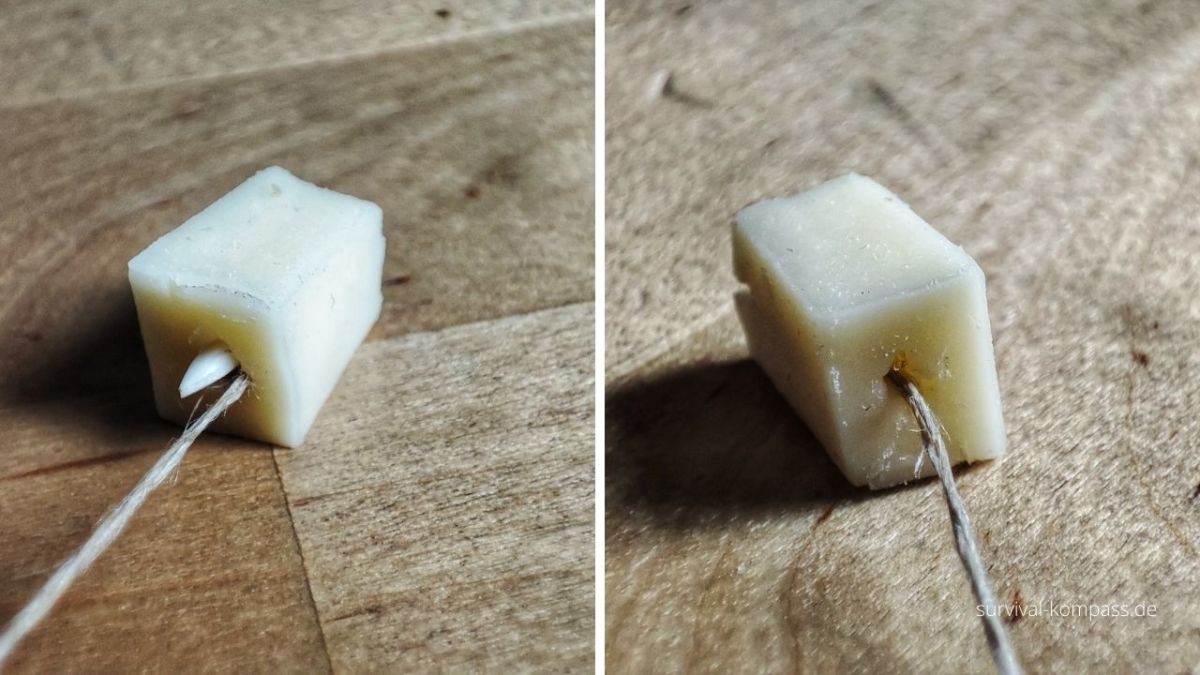
bait
Nomen
Meaning
Bait is a term commonly used in the outdoor and survival world to refer to a substance or object used to attract animals for various purposes. In the context of survival, bait can be used to lure animals for hunting or trapping, providing a valuable source of food in the wilderness. In bushcraft and camping, bait can also be used to attract wildlife for observation or photography. It is important to note that baiting animals should be done responsibly and in accordance with local regulations to ensure the well-being of both the animals and the environment.

Examples
„I love going fishing in the wilderness. One of the most important things I always bring with me is bait.“
„Last weekend, I went camping with my friends and we decided to go crabbing. We used pieces of chicken as bait and caught a lot of crabs.“
„When I go hunting, I always use bait to attract animals. It helps me set up a trap and increases my chances of catching something.“
„During my survival training, I learned how to make bait from natural materials. I used berries and insects to attract fish and other small animals.“
„If you want to catch a big fish, you need to use the right bait. I always research the type of fish I want to catch and choose the bait accordingly.“
Origin
The word "bait" originates from the Old Norse word "beita," which means "to cause to bite." It has its roots in the Scandinavian languages and was first used in English around the 13th century. The concept of baiting, or luring animals with food or other enticing substances, has been practiced for centuries as a means of hunting and fishing.
Over time, the term "bait" has evolved to encompass various forms and purposes. In the context of fishing, bait refers to any substance used to attract fish to a hook, such as worms, insects, or artificial lures. In hunting, bait can be used to lure animals into traps or hunting areas, often with the intention of capturing or killing them.
Bait has also found its way into other areas of human activity. In the realm of survival and wilderness skills, bait can be used to attract animals for food or as a means of self-defense. Additionally, bait is commonly used in pest control to attract and eliminate unwanted insects or rodents.
Overall, the word "bait" has a rich history and has evolved to encompass a wide range of applications in various fields. Its origins in the Old Norse language highlight its connection to ancient hunting and fishing practices, while its continued use in modern contexts demonstrates its enduring relevance.
Synonyms
Lure, Decoy, Enticement, Temptation, Attraction, Inducement, Hook, Snare
Antonyms
Repel, Dissuade, Repulse, Discourage, Deter
Relatives
Lure, Attractant, Decoy, Entice, Temptation, Entrapment, Seduction, Enticement
Historical and cultural importance
Bait has a long history of cultural and historical significance, particularly in the context of hunting and fishing. Throughout human history, bait has been used as a means to attract and capture animals for sustenance and sport.
In ancient civilizations, such as Egypt and Mesopotamia, bait was commonly used in fishing to lure fish into nets or traps. The use of bait allowed early humans to supplement their diet with a reliable source of protein.
In medieval Europe, bait played a crucial role in hunting practices. Hunters would use bait, such as animal carcasses or food scraps, to attract game animals, making it easier to track and capture them. This technique was especially prevalent in falconry, where bait was used to train and reward birds of prey.
Today, bait continues to be an essential tool for anglers and hunters. In fishing, bait can range from live worms and insects to artificial lures designed to mimic the movement and appearance of prey. The choice of bait depends on the target species and the fishing technique employed.
In hunting, bait is still used to attract game animals, particularly in the practice of baiting deer or bears. Hunters strategically place bait, such as corn or other food sources, to entice animals into specific areas, increasing the chances of a successful hunt.
Overall, the historical and cultural significance of bait highlights its importance in the realm of survival and outdoor activities. Understanding the role of bait in different contexts can enhance one's knowledge and skills in hunting, fishing, and wilderness survival.
More information about the term bait
What is Bait in Survival?
In the world of survival, bait refers to any substance or object used to attract and lure animals for various purposes. Whether you're hunting for food, setting traps, or trying to observe wildlife, bait can be a valuable tool in your arsenal. It can help increase your chances of success and provide you with essential resources in a survival situation.
Types of Bait
There are several types of bait that can be used in different survival scenarios:
Food Bait: This type of bait involves using edible substances to attract animals. It can be anything from fruits, vegetables, or meat scraps. Food bait is commonly used in hunting and trapping to lure animals into a specific area.
Scents and Lures: Scents and lures are substances that mimic the natural smells and pheromones of animals. They can be used to attract specific species or create curiosity among wildlife. Scents and lures are often used in fishing to attract fish to the baited hook.
Decoys: Decoys are objects that resemble animals or their prey. They can be used to attract predators or create a sense of safety for prey animals. Decoys are commonly used in hunting to lure animals within range.
Uses of Bait in Survival
Bait serves various purposes in survival situations:
Food Procurement: Bait can be used to attract animals for hunting or trapping, increasing your chances of procuring food. By strategically placing bait, you can create an opportunity to catch animals for sustenance.
Observation and Study: Bait can also be used to observe and study wildlife. By attracting animals to a specific area, you can gather valuable information about their behavior, habits, and patterns. This knowledge can be crucial for survival and understanding the environment.
Survival Signaling: In emergency situations, bait can be used as a signaling tool. By placing bait in an open area, you can attract attention from potential rescuers or other individuals who may be nearby.
Considerations when Using Bait
When using bait in survival situations, there are a few important considerations to keep in mind:
Local Laws and Regulations: Before using bait, ensure that you are familiar with local hunting and fishing regulations. Some areas may have restrictions on the use of bait or specific requirements for its use.
Proper Disposal: If you are using bait for hunting or fishing, it is essential to properly dispose of any unused bait or remains. Leaving bait behind can attract unwanted animals or disrupt the natural balance of the ecosystem.
Safety: When using bait, be mindful of your safety and the safety of others. Avoid using bait in areas with high human activity or where it may attract dangerous wildlife.
Bait can be a valuable tool in survival situations, providing you with opportunities for food procurement, observation, and signaling. By understanding the different types of bait and their uses, you can enhance your survival skills and increase your chances of success in the wild.
Back to overview

